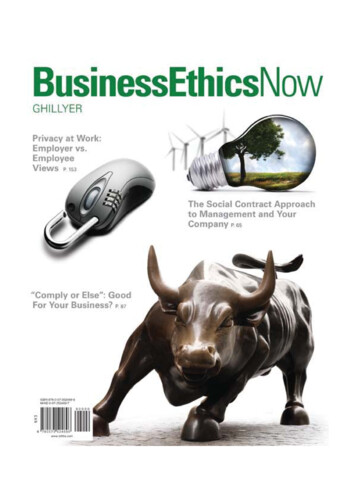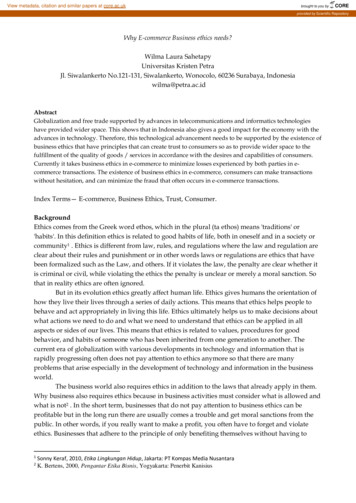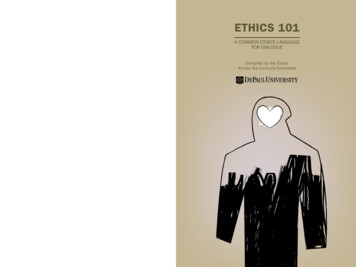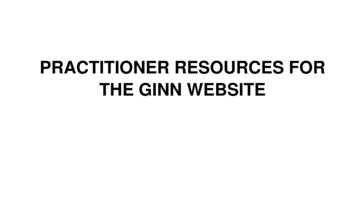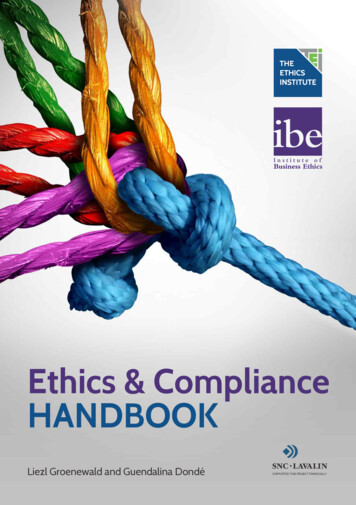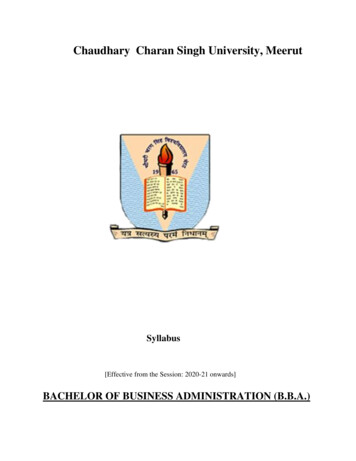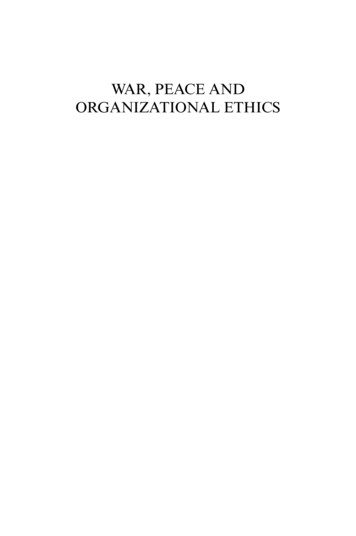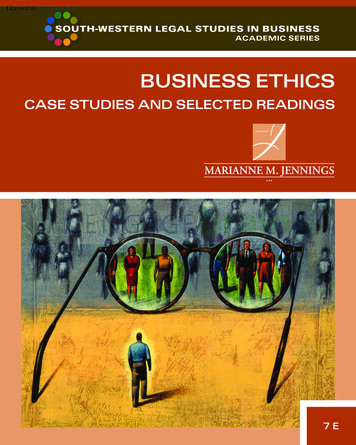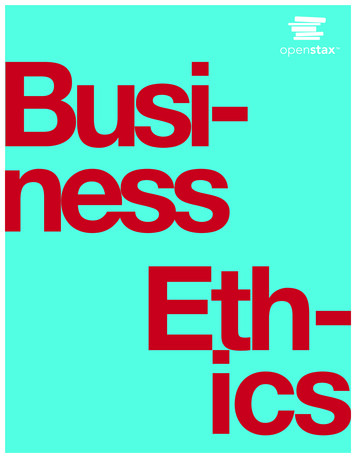
Transcription
Business EthicsSENIOR CONTRIBUTING AUTHORSSTEPHEN M. BYARS, USC MARSHALL SCHOOL OF BUSINESSKURT STANBERRY, UNIVERSITY OF HOUSTON-DOWNTOWN
OpenStaxRice University6100 Main Street MS-375Houston, Texas 77005To learn more about OpenStax, visit https://openstax.org.Individual print copies and bulk orders can be purchased through our website. 2018 Rice University. Textbook content produced by OpenStax is licensed under a Creative CommonsAttribution 4.0 International License (CC BY 4.0). Under this license, any user of this textbook or the textbookcontents herein must provide proper attribution as follows:----If you redistribute this textbook in a digital format (including but not limited to PDF and HTML), then youmust retain on every page the following attribution:“Download for free at .”If you redistribute this textbook in a print format, then you must include on every physical page thefollowing attribution:“Download for free at .”If you redistribute part of this textbook, then you must retain in every digital format page view (includingbut not limited to PDF and HTML) and on every physical printed page the following attribution:“Download for free at .”If you use this textbook as a bibliographic reference, please -ethics in your citation.For questions regarding this licensing, please contact support@openstax.org.TrademarksThe OpenStax name, OpenStax logo, OpenStax book covers, OpenStax CNX name, OpenStax CNX logo,OpenStax Tutor name, Openstax Tutor logo, Connexions name, Connexions logo, Rice University name, andRice University logo are not subject to the license and may not be reproduced without the prior and expresswritten consent of Rice University.PRINT BOOK ISBN-10PRINT BOOK ISBN-13PDF VERSION ISBN-10PDF VERSION ISBN-1310 9 8 7 6 5 4 3 2 947172-57-9
OPENSTAXOpenStax provides free, peer-reviewed, openly licensed textbooks for introductory college and AdvancedPlacement courses and low-cost, personalized courseware that helps students learn. A nonprofit ed techinitiative based at Rice University, we’re committed to helping students access the tools they need to completetheir courses and meet their educational goals.RICE UNIVERSITYOpenStax, OpenStax CNX, and OpenStax Tutor are initiatives of Rice University. As a leading researchuniversity with a distinctive commitment to undergraduate education, Rice University aspires to path-breakingresearch, unsurpassed teaching, and contributions to the betterment of our world. It seeks to fulfill thismission by cultivating a diverse community of learning and discovery that produces leaders across thespectrum of human endeavor.PHILANTHROPIC SUPPORTOpenStax is grateful for our generous philanthropic partners, who support our vision to improve educationalopportunities for all learners.Laura and John Arnold FoundationThe Maxfield FoundationArthur and Carlyse Ciocca Charitable FoundationBurt and Deedee McMurtryAnn and John DoerrMichelson 20MM FoundationBill & Melinda Gates FoundationNational Science FoundationGirard FoundationThe Open Society FoundationsGoogle Inc.Jumee Yhu and David E. Park IIIThe William and Flora Hewlett FoundationBrian D. Patterson USA-International FoundationRusty and John JaggersThe Bill and Stephanie Sick FundThe Calvin K. Kazanjian Economics FoundationRobin and Sandy Stuart FoundationCharles Koch FoundationThe Stuart Family FoundationLeon Lowenstein Foundation, Inc.Tammy and Guillermo Treviño
Study where you want, whatyou want, when you want.When you access College Success in our web view, you can use our new onlinehighlighting and note-taking features to create your own study guides.Our books are free and flexible, forever.Get started at openstax.org/details/books/business-ethicsAccess. The future of education.openstax.org
TABLE OF CONTENTSPreface11Why Ethics Matter71.1 Being a Professional of Integrity 81.2 Ethics and Profitability 131.3 Multiple versus Single Ethical Standards2Ethics from Antiquity to the Present2.12.22.32.42.52.6327The Concept of Ethical Business in Ancient Athens 28Ethical Advice for Nobles and Civil Servants in Ancient China 35Comparing the Virtue Ethics of East and West 40Utilitarianism: The Greatest Good for the Greatest Number 44Deontology: Ethics as Duty 50A Theory of Justice 54Defining and Prioritizing Stakeholders3.13.23.33.442067Adopting a Stakeholder Orientation 68Weighing Stakeholder Claims 72Ethical Decision-Making and Prioritizing StakeholdersCorporate Social Responsibility (CSR) 8378Three Special Stakeholders: Society, the Environment, andGovernment4.1 Corporate Law and Corporate Responsibility 944.2 Sustainability: Business and the Environment 1034.3 Government and the Private Sector 1175The Impact of Culture and Time on Business Ethics5.15.25.35.46The Relationship between Business Ethics and Culture 132Business Ethics over Time 139The Influence of Geography and Religion 144Are the Values Central to Business Ethics Universal? 149What Employers Owe Employees1596.1 The Workplace Environment and Working Conditions16013193
6.2 What Constitutes a Fair Wage?6.3 An Organized Workforce 1776.4 Privacy in the Workplace 1847What Employees Owe Employers7.17.27.37.47.58Loyalty to the Company 196Loyalty to the Brand and to Customers 203Contributing to a Positive Work Atmosphere 207Financial Integrity 212Criticism of the Company and Whistleblowing 218Changing Work Environments and Future Trends295More Telecommuting or Less? 296Workplace Campuses 301Alternatives to Traditional Patterns of Work 306Robotics, Artificial Intelligence, and the Workplace of the FutureEpilogue: Why Ethics Still Matter11.111.211.311.4A265Entrepreneurship and Start-Up Culture 266The Influence of Advertising 271The Insurance Industry 276Ethical Issues in the Provision of Health Care 28010.110.210.310.411231Diversity and Inclusion in the Workforce 232Accommodating Different Abilities and Faiths 239Sexual Identification and Orientation 244Income Inequalities 247Animal Rights and the Implications for Business 252Professions under the Microscope9.19.29.39.410195Recognizing and Respecting the Rights of All8.18.28.38.48.59169325Business Ethics in an Evolving Environment 326Committing to an Ethical View 329Becoming an Ethical Professional 332Making a Difference in the Business World 336The Lives of Ethical Philosophers341This OpenStax book is available for free at http://cnx.org/content/col25722/1.3314
BProfiles in Business Ethics: Contemporary Thought LeadersCA Succinct Theory of Business EthicsIndex365357347
This OpenStax book is available for free at http://cnx.org/content/col25722/1.3
Preface1PrefaceWelcome to Business Ethics, an OpenStax resource. This textbook was written to increase student access tohigh-quality learning materials, maintaining highest standards of academic rigor at little to no cost.About OpenStaxOpenStax is a nonprofit based at Rice University, and it’s our mission to improve student access to education.Our first openly licensed college textbook was published in 2012, and our library has since scaled to over 25books for college and AP courses used by hundreds of thousands of students. OpenStax Tutor, our low-costpersonalized learning tool, is being used in college courses throughout the country. Through our partnershipswith philanthropic foundations and our alliance with other educational resource organizations, OpenStax isbreaking down the most common barriers to learning and empowering students and instructors to succeed.About OpenStax resourcesCustomizationBusiness Ethics is licensed under a Creative Commons Attribution 4.0 International (CC BY) license, whichmeans that you can distribute, remix, and build upon the content, as long as you provide attribution toOpenStax and its content contributors.Because our books are openly licensed, you are free to use the entire book or pick and choose the sectionsthat are most relevant to the needs of your course. Feel free to remix the content by assigning your studentscertain chapters and sections in your syllabus, in the order that you prefer. You can even provide a direct linkin your syllabus to the sections in the web view of your book.Instructors also have the option of creating a customized version of their OpenStax book. The custom versioncan be made available to students in low-cost print or digital form through your campus bookstore. Visit theInstructor Resources section of your book page on OpenStax.org for information.Art attribution in Business EthicsIn Business Ethics, most art contains attribution to its title, creator or rights holder, host platform, and licensewithin the caption. Because the art is openly licensed, anyone may reuse the art as long as they provide thesame attribution to its original source.To maximize readability and content flow, some art does not include attribution in the text. If you reuse artfrom Business Ethics that does not have attribution provided, use the following attribution: Copyright RiceUniversity, OpenStax, under CC BY 4.0 license.ErrataAll OpenStax textbooks undergo a rigorous review process. However, like any professional-grade textbook,errors sometimes occur. Since our books are web based, we can make updates periodically when deemedpedagogically necessary. If you have a correction to suggest, submit it through the link on your book page onopenstax.org. Subject matter experts review all errata suggestions. OpenStax is committed to remainingtransparent about all updates, so you will also find a list of past errata changes on your book page onopenstax.org.
2PrefaceFormatYou can access this textbook for free in web view or PDF through OpenStax.org, and for a low cost in print.About Business EthicsBusiness Ethics is designed to meet the scope and sequence requirements of the single-semester standardizedbusiness ethics course across all majors. This title includes innovative features designed to enhance studentlearning, including case studies, application scenarios, and links to video interviews with executives, all ofwhich help instill in students a sense of ethical awareness and responsibility. The book provides an importantopportunity for students to learn the core concepts of business ethics and understand how to apply thoseconcepts to their professional lives.Coverage and scopeOur Business Ethics textbook adheres to the scope and sequence requirements of introductory business ethicscourses nationwide. We have endeavored to make the core theories and practical concepts of business ethicsengaging, relevant, and accessible to students. The guiding themes of the textbook are to promote highethical standards and to assist the integration of ethical thinking across the business school curriculum, withan end result of encouraging even greater ethical consciousness on the part of business practitioners beyondtheir graduation. We particularly emphasize the reality of today’s global business community and observe thatgeography, culture, and time contribute to ethical concepts and constructs. With awareness of these issues inmind, the content of this textbook has been developed and arranged to emphasize the necessity—anddifficulty—of ethical decision-making. The authors seek to help students recognize legal and moral issues,reason through the consequences of different courses of action, and promote social responsibility. The textemphasizes connections between topics such as ethical theories, legal responsibilities, the prioritization ofstakeholders, and corporate social responsibility. The organization and pedagogical features were developedand vetted with feedback from business ethics instructors dedicated to the project.Engaging feature boxesThroughout Business Ethics, you will find features that engage students by taking selected topics a step further.Each feature box contains either a link to a deeper exploration of the topic at hand or critical thinkingquestions that may be geared toward class discussion, student projects, or written essays. Our featuresinclude: Cases from the Real World. This feature presents brief examples of real companies making ethicaldecisions in the midst of hectic competition. Each example includes follow-up critical thinking questionsthat encourage reflection on the case and how it relates to chapter concepts and themes. What Would You Do? This feature presents brief, fact-based scenarios in which students are challengedto put themselves into the shoes of ranking executives and balance a host of interests—someconflicting—as they make decisions for their businesses. Students provide an answer to a practicalproblem or ethical issue, as well as their reasoning. Ethics across Time and Cultures. This feature considers how geography, culture, and time influence theethical values we have. Follow-up critical thinking questions allow for broader reflection on the chaptertopics and encourage deeper integration of the chapter content. Link to Learning. This feature provides a very brief introduction to online resources and videos that arepertinent to students’ exploration of the topic at hand. Link to Learning boxes allow students to connecteasily to some of the most important thought leaders and concepts in the field of business ethics. TheThis OpenStax book is available for free at http://cnx.org/content/col25722/1.3
Preface3purpose is to highlight the complexities of ethical decision-making.Module materials that reinforce key concepts Learning Objectives. Every module begins with a set of clear and concise learning objectives. Theseobjectives are designed to help the instructor decide what content to include or assign, and to guidestudents on what they can expect to learn. After completing the module and end-of-module exercises,students should be able to demonstrate mastery of the learning objectives. Summaries. Section summaries distill the information in each module for both students and instructorsdown to key, concise points addressed in the section. Key Terms. Key terms are bold and are followed by a definition in context. Definitions of key terms arealso listed in the glossary, which appears at the end of the chapter. Assessments. Multiple-choice and short-answer review questions provide opportunities to recall and testthe information students learn throughout each module.Additional resourcesStudent and instructor resourcesWe’ve compiled additional resources for both students and instructors, including Getting Started Guides, atest bank, and comprehensive PowerPoint slides. Instructor resources require a verified instructor account,which you can apply for when you log in or create your account on OpenStax.org. Take advantage of theseresources to supplement your OpenStax book.Community HubsOpenStax partners with the Institute for the Study of Knowledge Management in Education (ISKME) to offerCommunity Hubs on OER Commons—a platform for instructors to share community-created resources thatsupport OpenStax books, free of charge. Through our Community Hubs, instructors can upload their ownmaterials or download resources to use in their courses, including additional ancillaries, teaching material,multimedia, and relevant course content. We encourage instructors to join the hubs for the subjects mostrelevant to their teaching and research, as an opportunity to both enrich their courses as well as to engagewith other faculty.To reach the Community Hubs, visit www.oercommons.org/hubs/OpenStax.Technology partnersAs allies in making high-quality learning materials accessible, our technology partners offer optional low-costtools that are integrated with OpenStax books. To access the technology options for your text, visit your bookpage on OpenStax.org.About the authorsSenior contributing authorsStephen M. Byars, USC Marshall School of BusinessStephen Byars received his BA from Claremont McKenna College, his MA from the University of San Diego, andhis PhD from the University of Southern California. He teaches business ethics and oral and writtencommunication at the Marshall School of Business at USC to both graduate and undergraduate businessmajors. He has served as associate director of the USC Writing Program, temporary director of the Writing
4PrefaceCenter within the Writing Program, and as director of the USC Marshall Consulting Program. His scholarlyinterests include business and professional ethics, the constructive mediation of disputes in the workplace,and those best practices that permit leaders to direct business in ways that engender community, social, andcorporate good.Kurt Stanberry, University of Houston–DowntownKurt Stanberry is a professor of legal studies in the College of Business at the University of Houston Downtownand has held the PLM Endowed Professorship since 2011. He is also a licensed attorney. He received his BAfrom Yale University, an MBA from the Graduate School of Business at Temple University, and a JD from theUniversity of Houston College of Law.Kurt teaches courses at the undergraduate and graduate level in business law, contracts, employment law,negotiations, ethics, and other related topics. He also conducts continuing education seminars in topics suchas negotiations, leadership, diversity, and ethics for CPAs, CFPs, attorneys, and business executives, throughorganizations such as the AICPA, FEI, and TSCPA at the state and national levels. He has published numerousarticles in scholarly journals, two textbooks, various practice manuals, and cases. Prior to joining the faculty atUHD, Kurt was a professor in the California State University System and was also a visiting professor ininternational programs in London, Bonn, Tokyo, and Seoul. He has been teaching and practicing law for over30 years.Contributing authorsBarbara Boerner, Brevard CollegeRobert Brancatelli, Fordham UniversityWade Chumney, California State University, NorthridgeLaura Dendinger, Wayne State CollegeBill Nantz, Houston Community CollegeMark Poepsel, Southern Illinois University EdwardsvilleDavid Shapiro, Pennsylvania State UniversityReviewersJustin Bateh, Florida State College at JacksonvilleRonald Berenbeim, New York UniversityKenneth Bigel, Touro CollegeCindy Briggs, Salt Lake Community CollegeBarbara Chappell, Walden UniversityMaureen Chisholm, Quincy CollegeValerie Collins, Sheridan CollegeDixon Cooper, Ouachita Baptist UniversityAnastasia Cortes, Virginia Polytechnic InstituteSarah Esveldt, Carroll UniversityRand Fandrich, New England College of BusinessCharles Fenner, State University of New York CantonThis OpenStax book is available for free at http://cnx.org/content/col25722/1.3
PrefaceMehran Ferdowsian, Wilkes UniversityBetty Fitte, Tidewater Community CollegeRobert Freeborough, Berkeley CollegeMartha Helland, University of Sioux FallsAmy Jordan, Loyola University ChicagoStephanie Jue, University of TexasCheryl Keymer, North Arkansas CollegeNai Lamb, University of Tennessee at ChattanoogaJolene A. Lampton, Park University–Austin CampusBarbara Limbach, Chadron State CollegeMarilyn Marousek, Barry UniversityRuss Meade, Husson UniversityMichael Pakaluk, Catholic UniversityTatyana Pashnyak, Bainbridge State CollegeRoslyn Roberts, California State University, SacramentoAmber Ruszkowski, Ivy Tech Community CollegeRichard Savior, State University of New York Empire State CollegeLon Schiffbauer, Salt Lake Community CollegeNathan Smith, Houston Community CollegeAnne Snell, Tulane UniversityChris Suprenant, University of New OrleansGlen Taylor, Paradise Valley Community CollegeSonia Toson, Kennesaw State UniversityJoel Webb, Loyola University New OrleansAndy Wible, Muskegon Community CollegeJeffrey Yoder, Fairfield University5
PrefaceThis OpenStax book is available for free at http://cnx.org/content/col25722/1.3
1Why Ethics MatterFigure 1.1 Each of us makes innumerable decisions every day. In a business context, these choices haveconsequences for ourselves and others whom we must take into account in our decision-making process.(credit: modification of “business paper office laptop” by “rawpixel”/Pixabay, CC0)Chapter Outline1.1 Being a Professional of Integrity1.2 Ethics and Profitability1.3 Multiple versus Single Ethical StandardsIntroductionEthics consists of the standards of behavior to which we hold ourselves in our personal and professional lives.It establishes the levels of honesty, empathy, and trustworthiness and other virtues by which we hope toidentify our personal behavior and our public reputation. In our personal lives, our ethics sets norms for theways in which we interact with family and friends. In our professional lives, ethics guides our interactions withcustomers, clients, colleagues, employees, and shareholders affected by our business practices (Figure 1.1).Should we care about ethics in our lives? In our practices in business and the professions? That is the centralquestion we will examine in this chapter and throughout the book. Our goal is to understand why the answeris yes.Whatever hopes you have for your future, you almost certainly want to be successful in whatever career youchoose. But what does success mean to you, and how will you know you have achieved it? Will you measure itin terms of wealth, status, power, or recognition? Before blindly embarking on a quest to achieve these goals,which society considers important, stop and think about what a successful career means to you personally.Does it include a blameless reputation, colleagues whose good opinion you value, and the ability to think wellof yourself? How might ethics guide your decision-making and contribute to your achievement of these goals?
8Chapter 1 Why Ethics Matter1.1Being a Professional of IntegrityLearning ObjectivesBy the end of this section, you will be able to: Describe the role of ethics in a business environment Explain what it means to be a professional of integrity Distinguish between ethical and legal responsibilities Describe three approaches for examining the ethical nature of a decisionWhenever you think about the behavior you expect of yourself in your personal life and as a professional, youare engaging in a philosophical dialogue with yourself to establish the standards of behavior you choose touphold, that is, your ethics. You may decide you should always tell the truth to family, friends, customers,clients, and shareholders, and if that is not possible, you should have very good reasons why you cannot. Youmay also choose never to defraud or mislead your business partners. You may decide, as well, that while youare pursuing profit in your business, you will not require that all the money on the table come your way.Instead, there might be some to go around to those who are important because they are affected one way oranother by your business. These are your stakeholders.Acting with IntegrityClients, customers, suppliers, investors, retailers, employees, the media, the government, members of thesurrounding community, competitors, and even the environment are stakeholders in a business; that is, theyare individuals and entities affected by the business’s decisions (Figure 1.2). Stakeholders typically value aleadership team that chooses the ethical way to accomplish the company’s legitimate for-profit goals. Forexample, Patagonia expresses its commitment to environmentalism via its “1% for the Planet” program, whichdonates 1 percent of all sales to help save the planet. In part because of this program, Patagonia has becomea market leader in outdoor gear.This OpenStax book is available for free at http://cnx.org/content/col25722/1.3
Chapter 1 Why Ethics MatterFigure 1.29Stakeholders are the individuals and entities affected by a business’s decisions, including clients,customers, suppliers, investors, retailers, employees, the media, the government, members of the surroundingcommunity, the environment, and even competitors. (attribution: Copyright Rice University, OpenStax, underCC BY 4.0 license)Being successful at work may therefore consist of much more than simply earning money and promotions. Itmay also mean treating our employees, customers, and clients with honesty and respect. It may come fromthe sense of pride we feel about engaging in honest transactions, not just because the law demands it butbecause we demand it of ourselves. It may lie in knowing the profit we make does not come fromshortchanging others. Thus, business ethics guides the conduct by which companies and their agents abideby the law and respect the rights of their stakeholders, particularly their customers, clients, employees, andthe surrounding community and environment. Ethical business conduct permits us to sleep well at night.LINK TO LEARNINGAre business ethics an oxymoron? Read “Why Ethics Matter” to understand (https://openstax.org/l/53oxymoron) just a few of the reasons to have values-driven management.Nearly all systems of religious belief stress the building blocks of engaging others with respect, empathy, andhonesty. These foundational beliefs, in turn, prepare us for the codes of ethical behavior that serve as idealguides for business and the professions. Still, we need not subscribe to any religious faith to hold that ethicalbehavior in business is still necessary. Just by virtue of being human, we all share obligations to one another,and principal among these is the requirement that we treat others with fairness and dignity, including in ourcommercial transactions.
10Chapter 1 Why Ethics MatterFor this reason, we use the words ethics and morals interchangeably in this book, though some philosophersdistinguish between them. We hold that “an ethical person” conveys the same sense as “a moral person,” andwe do not regard religious belief as a requirement for acting ethically in business and the professions. Becausewe are all humans and in the same world, we should extend the same behavior to all. It is the right way tobehave, but it also burnishes our own professional reputation as business leaders of integrity.Integrity—that is, unity between what we say and what we do—is a highly valued trait. But it is more than justconsistency of character. Acting with integrity means we adhere strongly to a code of ethics, so it impliestrustworthiness and incorruptibility. Being a professional of integrity means consistently striving to be the bestperson you can be in all your interactions with others. It means you practice what you preach, walk the talk,and do what you believe is right based upon reason. Integrity in business brings many advantages, not theleast of which is that it is a critical factor in allowing business and society to function properly.Successful corporate leaders and the companies they represent will take pride in their enterprise if theyengage in business with honesty and fair play. To treat customers, clients, employees, and all those affected bya firm with dignity and respect is ethical. In addition, laudable business practices serve the long-term interestsof corporations. Why? Because customers, clients, employees, and society at large will much more willinglypatronize a business and work hard on its behalf if that business is perceived as caring about the community itserves. And what type of firm has long-term customers and employees? One whose track record givesevidence of honest business practice.LINK TO LEARNINGIn this interview, Mark Faris, a white-collar criminal convicted of fraud, claims that greed, arrogance, andambition were motivating factors (https://openstax.org/l/53MarkFaris) in his actions. He also discussesthe human ability to rationalize our behavior to justify it to ourselves. Note his proposed solutions:practicing ethical leadership and developing awareness at an individual level via corporate training.Many people confuse legal and ethical compliance. They are, however, totally different and call for differentstandards of behavior. The concepts are not interchangeable in any sense of the word. The law is needed toestablish and maintain a functioning society. Without it, our society would be in chaos. Compliance with theselegal standards is strictly mandatory: If we violate these standards, we are subject to punishment asestablished by the law. Therefore, compliance in terms of business ethics generally refers to the extent towhich a company conducts its business operations in accordance with applicable regulations, statutes, andlaws. Yet this represents only a baseline minimum. Ethical observance builds on this baseline and reveals theprinciples of an individual business leader or a specific organization. Ethical acts are generally consideredvoluntary and personal—often based on our perception of or stand on right and wrong.Some professions, such as medicine and the law, have traditional codes of ethics. The Hippocratic Oath, forexample, is embraced by most professionals in health care today as an appropriate standard always owed topatients by physicians, nurses, and others in the field. This obligation traces its lineage to ancient Greece andthe physician Hippocrates. Business is different in not having a mutually shared standard of ethics. This ischanging, however, as evidenced by the array of codes of conduct and mission statements many companieshave adopted over the past century. These have many points in common, and their shared content mayeventually produce a code universally claimed by business practitioners. What central point might constituteThis OpenStax book is available for free at http://cnx.org/content/col25722/1.3
Chapter 1 Why Ethics Matter11such a code? Essentially, a commitment to treat with honesty and integrity customers, clients, employees, andothers affiliated with a business.The law is typically indebted to tradition and precedence, and compelling reasons
TABLE OF CONTENTS Preface 1 1 Why Ethics Matter 7 1.1 Being a Professional of Integrity 8 1.2 Ethics and Profitability 13 1.3 Multiple versus Single Ethical Standards 20 2 Ethics from Antiquity to the Present 27 2.1 The Concept of Ethical Business in Ancient Athens 28 2.2 Ethical Advice for Nobles and Civil Servants in Ancient China 35 2.3 Comparing the Virtue Ethics of East and West 40


